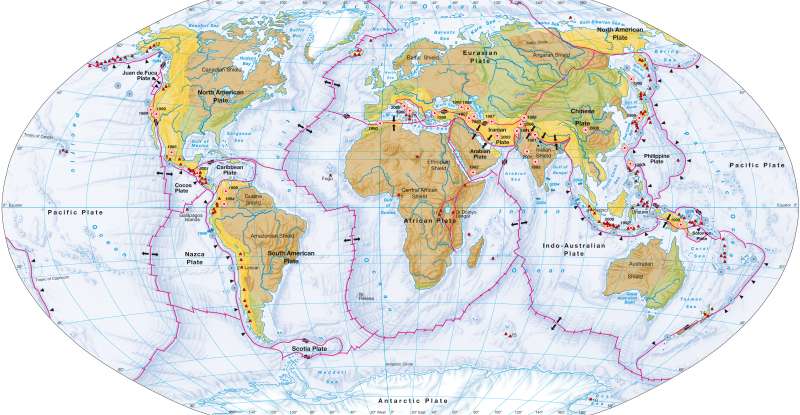Plate tectonics, volcanism and earthquakes
The world - Plate tectonics
978-3-14-100790-9 | Page 174 | Ill. 1

Information
The continental and the oceanic crust are in a so-called isostatic equilibrium. In accordance with this isostatic principle, the continents only protude above the oceanic crust so far as it corresponds to their lower rock density. The continents have cores of metamorphic and plutonic rocks, which mostly originate from the Precambrian period and which were widened in the course of several orogener cycles. Since the Cambrian Period these "original continents", in the meantime subject to profound/deep erosion, have been entirely flooded by shallow shelf seas and therefore undisturbed sedimentation has taken place in some areas.Earthquake and Volcanism
The plate boundaries distinguish themselves through elevated seismic, volcanic and tectonic activity. The results of earthquake evaluation have shown that their epicentres are concentrated in narrow zones in oceanic areas. At a certain strength, Tsunamis occur as a consequence of these seaquakes. The energy set free in the form of an elastic wave at the respective hypocentre of an earthquake is recorded on a logarithmic energy scale (Magnitude of the Richter Scale). The strongest registered earthquake to date had a magnitude of 9.3 (Sumatra-Andaman quake 2005). Shallow quakes from a depth of less than 70 kilometres occur increasingly often on the oceanic ridge and in the course of the oceanic trenches. Intermediary vibrations with a depth of 70 to 300 kilometres and almost all deep vibrations up to maximum 700 kilometres are concentrated in an approximately 250 kilometre wide belt of the continent-ward diving subduction-zones. On the continents, however, the seismic centres connected above all to the trench zones, are scattered more widely.
More than 75 percent of current volcanic activity is on the "Pacific Ring of Fire"; a chain of active volcanoes which runs parallel to the oceanic trenches. This volcanism results from smelting processes, which are from the diving of the oceanic crust in the area of the subduction zones in this context and chemically consists of Andesites and Rhyolithes. The typical, conical layer volcanoes are shown in the image overall. The volcanism of the continents follows the deep trench breaks and usually is basaltic in nature. Also basaltic volcanism characterises the comb region of the oceanic ridges. The typical volcano shape here is the shield volcano.
V. Kaminske; Ü: C. Fleming




